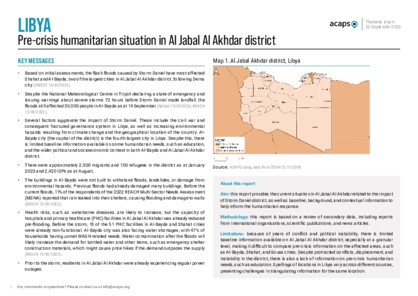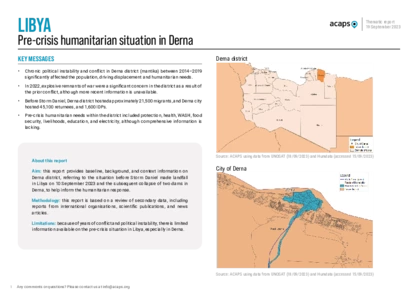Latest updates on country situation
06 August 2025
Following EU–Libya discussions on irregular migration in early July 2025, there has been a spike in the arbitrary detention of migrants in an irregular status. On 27 July, western Libyan authorities detained approximately 1,500 undocumented migrant workers, mainly Egyptians and sub-Saharan Africans, after raiding a compound east of Tripoli. They lacked residency permits, passports, and health records and lived in makeshift housing that did not meet basic safety standards. On 20 July, eastern Libyan authorities deported 700 Sudanese migrants after detaining and denying them access to needed medical services. Up until April, Libya was hosting over 867,000 migrants, refugees, and asylum seekers. They face high protection needs, including arbitrary detention and deportation by security forces and exploitation by smugglers. Migrants aim to cross the central Mediterranean, one of the deadliest migration routes to Europe, with over 1,100 migrants dying in 2024 and nearly 2,000 in 2023. (TNA 27/07/2025, IM 02/07/2025, IM 21/07/2025)
23 July 2025
On 20 July 2025, eastern Libyan authorities deported 700 Sudanese migrants after detaining and denying them access to needed medical services, including treatment for infectious diseases. Until April, an estimated 867,000 migrants, refugees, and asylum seekers were in the country, nearly 33% of whom were from Sudan. They continue to experience high protection needs, as they are subject to exploitation by human traffickers, arbitrary detention and deportation by Libyan authorities, and lack of access to basic services, such as healthcare. (IOM 21/07/2025, IM 21/07/2025)
26 February 2025
Between November–December 2024, Libya hosted more than 824,000 migrants, refugees, and asylum seekers, who continue to face high protection needs as a result of arbitrary detention, physical assault, and exploitation, especially by human traffickers. During a raid on a human trafficking network in February 2025, at least two mass graves, with 93 bodies believed to be of the same demographic, were found in Jakharrah and Kufra districts. Most of these people are sub-Saharan Africans. They face access restrictions to services, including healthcare, especially those who face physical abuse in detention centres. There is a need for mental health support for those with post-traumatic stress disorders, victims of sexual violence, and other cases. People on the move also need shelter services, as they mostly stay in overcrowded shared rooms or building sites that can be unhealthy and dangerous, exposing them to the risk of diseases. (IOM 25/02/2025, IM 20/02/2025, MSF 12/02/2025)
01 October 2024
The conflict in Sudan since April 2023 has led to an influx of Sudanese refugees into Libya. More than 98,700 refugees had arrived by 29 September 2024, with most staying in southern Libya. Despite being allowed entry, refugees are not recognised under Libyan law and face protection risks, including trafficking, smuggling, assault, and detention. The influx has severely strained healthcare and nutrition services, particularly in border areas such as Al Kufra district, where malnutrition and a lack of medical supplies have been reported. The rising costs of basic goods and limited job opportunities also leave many unable to afford rent or access essential services. Although refugee children are permitted to attend schools, overcrowding and insufficient resources strain the education system. Refugees also lack access to clean water and face a shortage of latrines, leading to a risk of disease outbreaks. (UNHCR 29/09/2024, UNHCR 02/07/2024, IRC 12/08/2024)
27 August 2024
Floods since 16 August 2024 have been affecting southwestern Libya, mainly the towns of Ghat and Tahala. The flooding has displaced nearly 6,100 people, who are staying with relatives or in camps and schools. Some facilities, such as a police station and health centres, have closed because of the floods, which have also damaged around 40 farms. Urgent needs include food, clean drinking water, and personal hygiene kits. (IOM 18/08/2024, ECHO 20/08/2024)
05 June 2024
The number of people in mixed movements in Libya has surged to the highest levels since the COVID-19 pandemic. By May 2024, there were more than 63,400 registered refugees and asylum seekers in the country, while 719,000 migrants were identified between January–February. Most of the migrants left their origin countries of Egypt, Niger, and Sudan because of economic hardship, unemployment, or insecurity. These people on the move continue to face significant protection challenges and widespread human rights abuses. Many who attempt to cross to Europe are intercepted at sea and forcibly returned to Libya, where they face the risk of arbitrary detention, torture, and extortion in official and unofficial detention centres. In these facilities, conditions are harsh, with severe overcrowding and inadequate medical care. The involvement of traffickers aggravates their vulnerability, leading to increased exploitation and violence. (UNHCR accessed 05/06/2024, IOM 30/04/2024, MMC 07/02/2024)
21 February 2024
There has been an influx of Sudanese refugees to Kufra district, southeastern Libya, since nearly mid-February 2024. Their needs include shelter, food, and NFIs, as aid from the Libyan National Army is not enough, and the district does not have the capacity to cover the growing needs. As at 11 February, more than 6,000 refugees from Sudan had crossed into Libya. (Dabanga 16/02/2024, IOM 13/02/2024)
current crises
in
Libya
These crises have been identified through the INFORM Severity Index, a tool for measuring and comparing the severity of humanitarian crises globally.
LBY005 - Multiple crises
Last updated 27/11/2025
Drivers
International Displacement
Crisis level
Country
Severity level
3.3 High
Access constraints
3.0
LBY004 - Displacement from Sudan
Last updated 27/11/2025
Drivers
International Displacement
Crisis level
Country
Severity level
3.1 High
Access constraints
3.0
LBY002 - International displacement
Last updated 27/11/2025
Drivers
International Displacement
Crisis level
Country
Severity level
3.1 High
Access constraints
3.0
Analysis products
on
Libya
30 January 2024
Libya: mental health and psychosocial support (MHPSS) needs of Storm Daniel-affected communities
DOCUMENT / PDF / 438 KB
Between 9–11 September 2023, Storm Daniel hit northeastern Libya. The storm had a significant impact on the mental health and psychosocial wellbeing of affected communities.
27 October 2023
Libya: anticipated impacts of the rainy season
DOCUMENT / PDF / 1 MB
This report aims to identify the anticipated impacts of the upcoming rainy season in northern Libya, where communities are still recovering from Storm Daniel. It seeks to inform anticipatory action, preparedness, and emergency response among humanitarian organisations.
22 September 2023
Libya: pre-crisis humanitarian situation in Al Jabal Al Akhdar district
DOCUMENT / PDF / 1 MB
This report provides the current situation in Al Jabal Al Akhdar related to the impact of Storm Daniel district, as well as baseline, background, and contextual information to help inform the humanitarian response.
19 September 2023
Libya: pre-crisis humanitarian situation in Derna
DOCUMENT / PDF / 576 KB
This report provides baseline, background, and context information on Derna district, referring to the situation before Storm Daniel made landfall in Libya on 10 September 2023 and the subsequent collapse of two dams in Derna, to help inform the humanitarian response.






